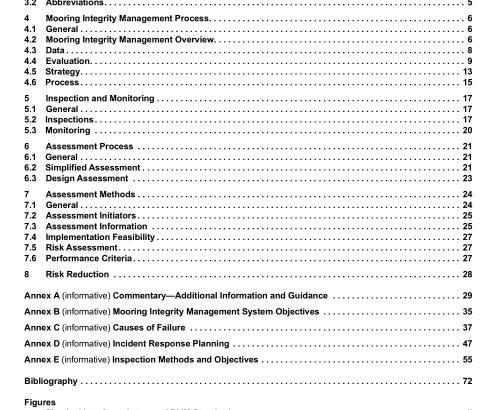API RP 2MIM:2019 pdf free download.Mooring Integrity Management
4 Mooring Integrity Management Process
4.1 General Mooring integrity management (MIM) is the process for ensuring a mooring’s fitness-for-service over its entire life. IM is a process for managing the effects of deterioration, changes in loading, and accidental overload. The objectives of a mooring IM process include detection of possible degradation of a mooring component sufficiently early to allow for remedial action and thereby protect against accidents, loss of life, environmental pollution, as well as minimizing downtime and risk of economic loss.
The process should be designed to provide data and information that may be used to develop remaining service life estimates and to support the possibility of life extension requests. The IM process should detect abnormal conditions or parameters outside of design envelopes through regular inspection and monitoring programs. The IM process provides the opportunity for owners/operators and engineers to adopt risk-based principles for developing IM strategies that consider the current condition of a mooring, the likelihood of damage or degradation of a mooring, and the potential consequences.
A risk-based approach recognizes that moorings with higher risks can warrant more frequent and more focused inspection than lower risk moorings. During the development of an inspection strategy, the mooring risk category may be used for setting survey intervals and work scopes as part of a risk-based IM strategy. The IM process consists of four elements, which are described in detail in this section, and flowchart showing the components of the IM process is shown in Figure 1:
— data; — evaluation;
— strategy;
— program. Periodic updates to the IM process should be performed and should follow a performance improvement cycle process, taking into account the latest information on the mooring system, as well as the host platform. Throughout the IM life cycle there are different system objectives. Examples are provided in Annex B.
4.2 Mooring Integrity
Management Overview IM is a continuous process used for demonstrating the fitness-for-service of a mooring system from installation through to decommissioning. IM provides the process for understanding the effects of deterioration, damage, changes in loading, and accidental overloading. In addition, IM provides a framework for inspection planning, maintenance, and repair of a mooring. The IM process is shown in Figure 2 with the four primary elements it consists of and information on their intended purposes. Data categories include design, inspection, monitoring, and operations. Data can come from technology development and experience within industry.
The data are evaluated to demonstrate fitness-for-service, and the IM strategy is adjusted, if necessary. The results from the evaluation are used to develop and implement an inspection strategy. The process is the implementation of the inspection, maintenance, and repair work scopes, as defined from the IM strategy.
4.3 Data
4.3.1 General The most recent representative mooring information shall be used for the IM process. Data collection starts from design and continues throughout the life of the mooring. Information on the original design, fabrication, and installation, in-service inspections, engineering evaluations, structural and mechanical assessments, modifications, strengthening, repairs, and operational incidents, all constitute parts of the IM database. IM data fall into two broad categories: (1) characteristic data and (2) condition data.
4.3.2 Characteristic
Data The mooring’s characteristic data are the baseline data that represent the mooring at insalltion. The characteristic data include:
General mooring data should include the mooring design basis, containing the design information, including design criteria, codes and standards used, as well as water depth, seabed topography, geotechnical data, metocean conditions, platform configuration, dependence on related systems, etc.
Mooring design data should provide a record of the as-designed condition of the mooring. It should include the design calculations, drawings, and installation or operating information that affects the design (e.g. corrosion protection), and reference the mooring analysis sofware/program and its version as used for design approval. It should also include any hazard identification and risk assessment work that may be used in the design and future IM.
Mooring fabrication data should provide a record of the as-built condition of the mooring components after FAT and prior to installation. It should include the specifications, material testing reports, welding procedure qualifications,NDE records, FAT records, repair and nonconformance records, coating records, as-built information, and vendor data books.
Mooring installation data should provide a record of how the mooring was installed, including installation specifications,procedures, activity logs, welding and NDE procedures, coating information, repair and nonconformance records, material tracking, and as-installed information.API RP 2MIM pdf download.API RP 2MIM:2019 pdf free download
